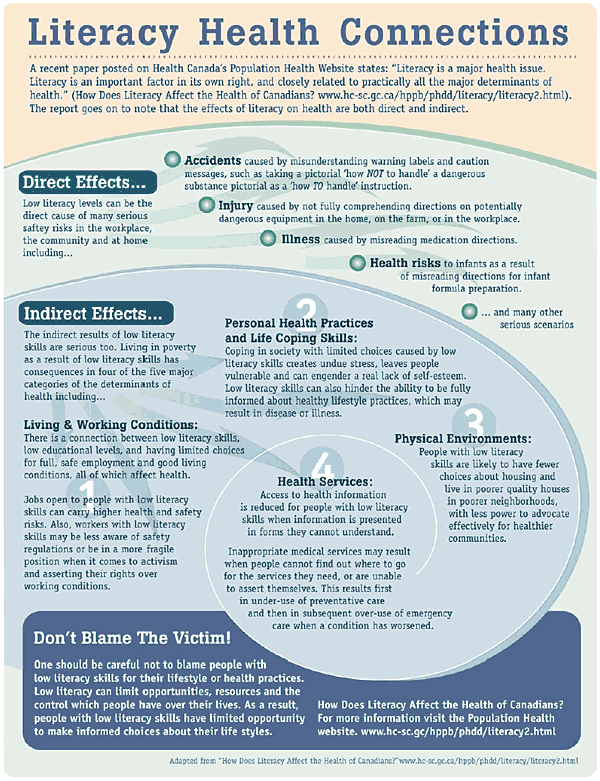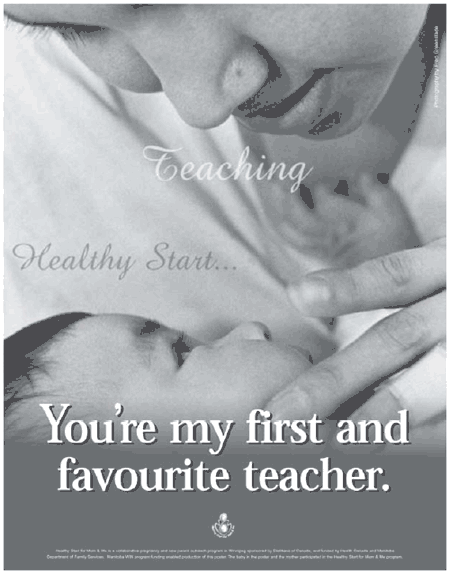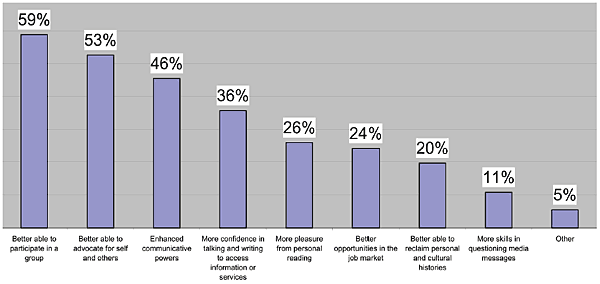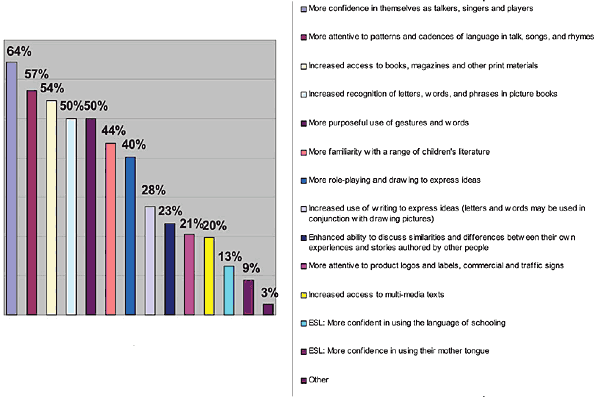Common menu bar links
Institutional links
Diseases & Conditions
Health & Safety
Research & Statistics
Agency Information
Search Box
E-mail this page
Language, Literacy and Healthy Development: The Work of CAPC and CPNP Projects
Introduction
Literacy is related in multiple ways to healthy development. Consequently it has become a serious concern for Health Canada. Recognizing literacy as a major health issue, Population Health notes that "literacy is an important factor in its own right, and closely related to practically all the major determinants of health." The effects of literacy on health are both direct and indirect; whether the health issue is the safe administration of medications and infant formulas or the ability to secure food and housing, literacy is involved (How Does Literacy Affect the Health of Canadians? Health Canada. Population Health, Government of Canada. 3 July 2003).
A great deal of literacy education and support is ongoing in Health Canada's Community Action Program for Children (CAPC) and the Canada Prenatal Nutrition Program (CPNP) projects. Often this kind of assistance is deeply embedded in the health education and parenting support these projects offer; sometimes it may take the form of specific literacy programs directed to parents and children. To capture the richness and diversity of this ongoing literacy work, Health Canada's National Projects Fund invested in a survey of CAPC and CPNP projects across Canada. The results of this survey have provided the basis for this resource, which relies heavily on the words and ideas of project staff. In this way, the work and words of those on the front lines can inspire the future of literacy education and provide concrete guidance to CAPC and CPNP projects across Canada.
Purpose of this resource
- To communicate how CAPC and CPNP projects make connections between language, literacy and healthy development
- To provide relevant support to CAPC and CPNP managers and staff
so they can:
- Ensure that families with diverse language and literacy backgrounds can access information about maternal and child health, child development and parenting;
- Address the everyday literacy needs and desires of Canadian families;
- Choose literacy programs and practices that build on families' strengths to support infant/child development.
Practitioners supporting practitioners
Because this resource draws heavily on the experience of project staff who incorporate literacy education and support into their health, parenting and child development programs on a daily basis, we have used their ideas and words extensively. More than 100 of them responded to the Literacy Matters survey, which was distributed to all English and bilingual CAPC and CPNP projects in Fall 2003. Responses were diverse, as might be expected in a vast, multi-cultural country such as Canada.
While the survey identified some differences in how CAPC and CPNP projects approach literacy education and support, there were striking similarities too. These included:
- Practical, down-to-earth approaches to literacy education and support;
- Respect for the dignity of participants who struggle with print;
- Sensitivity to literacy, linguistic, and cultural diversity;
- Commitment to honour participants' strengths and address their needs;
- Ingenuity in adapting literacy practices, programs, and materials to meet these needs.
Literacy for the 21st Century. What counts?
The very meaning of literacy changes with the times. For instance, advances in technology mean that information can now be accessed using computers, websites and videos. Canadians are learning to negotiate hypertext, icons, audio tracks, moving images and multiple screens, all at once. For many, the screen holds more allure than simple, printed texts. A picture tells a thousand words. Being literate is therefore no longer confined to reading words on a page.
Neither is literacy just a set of skills that can easily migrate across social, linguistic, and cultural boundaries. Canadians bring many different languages and cultures as frames of reference to understanding what they read. In fact, without the appropriate cultural and linguistic context, print just doesn't make sense.
And being literate in one sphere does not even guarantee it in another. Try reading a computer manual to test this out! Even if you can mouth the words, do you know what they mean? And can you put them to use?
So what counts as literacy? And whose literacy counts? Reading, writing and speaking in languages other than English or French all count as literacy, even though standardized Canadian literacy tests would discount them. Understanding culturally specific information - such as First Nations oral traditions - also counts. In fact, any communication practice that enables a person to function effectively in their local social and cultural contexts and participate in decisions that affect them must also be understood as literacy.
|
It is with this new vision of literacy, embracing technological advances as well as social, linguistic and cultural diversity, that health professionals must step forward into the 21st century.
|
|
Literacy Health Connections
 |
Literacy outcomes for CAPC/CPNP Projects
The Literacy Matters survey asked CAPC and CPNP projects to identify which literacy outcomes were achieved by adults and children. The results indicate that whilst a range of adult literacy outcomes are achieved, the primary emphasis in CAPC and CPNP is on adults in their capacity as parents, and on children.
Outcomes for Adults
According to the survey, outcomes most often achieved for adults in their own right are: participation in a group; advocacy for self and others; powers of communication, and confidence in talking and writing. Many projects noted that participation in a group is counted as a major accomplishment for participants who have formerly been socially isolated.
Personal pleasure in reading, job related skills, and cultural literacies were also identified as outcomes for adults, but by fewer projects (See graph 1).
|
Outcomes for Parents
Almost all programs reported that parents gain knowledge and a range of skills in their capacity as their children's first literacy teachers. Parents also gained a better understanding of texts relating to child development, health and safety in almost 50% of the projects.
|
Outcomes for Infants and Young Children
Outcomes relating to oral language - confidence in speaking and attention to patterns of language - were most often reported. Access to books and recognition of print patterns were also frequently mentioned. These factors, along with play and drawing, which were also identified, are generally recognised as foundational to the development of literacy in young children.
|
ESL outcomes were identified by a relatively small percentage of projects. However, this should not be taken as an indication of responsiveness to ESL participants, since most projects reported sensitive and innovative strategies to include a range of linguistic and cultural groups (see Section 2).

 2003
2003


